Maximize Freezer Space: Tips for Efficient Food Storage
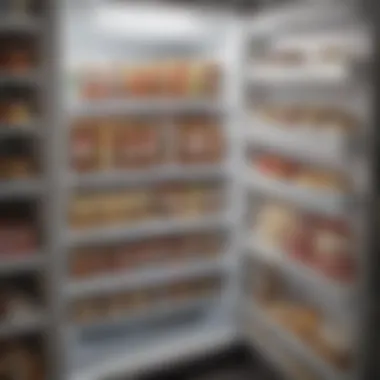
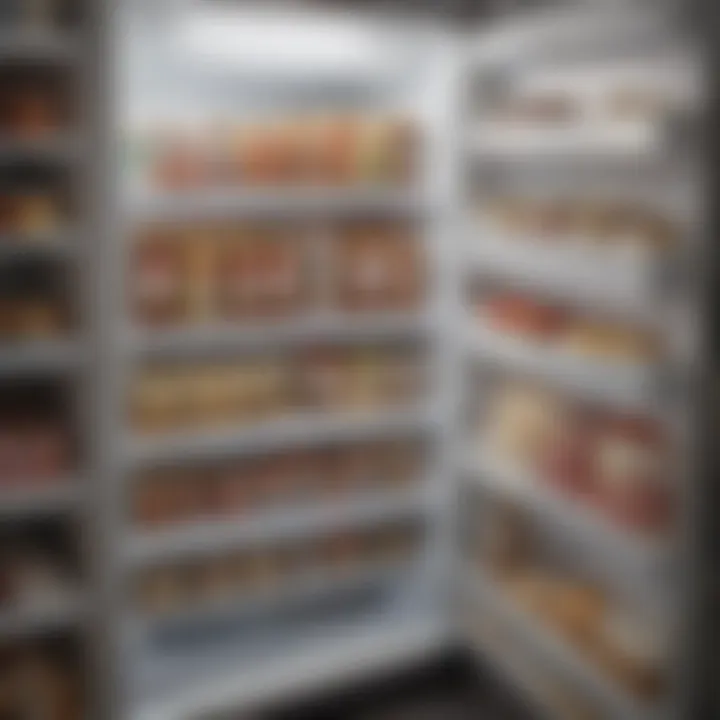
Intro
In our fast-paced world, the freezer is more than just a box for icy storage; it's a treasure trove for the savvy cook. From preserving leftovers to preparing for busy weekdays, understanding the ins and outs of freezer usage is crucial. This guide dives into practical solutions and strategies that not only maximize your freezer space but also improve your meal prep efficiency. Think about it: a well-organized freezer can cut down on waste, save you time, and even optimize your grocery budget.
As we proceed, prepare to explore techniques for organizing your items, the best methods for freezing food, and strategies to keep everything fresh longer. Additionally, we’ll delve into innovative meal preparation ideas that can transform your cooking process. So, roll up your sleeves and get ready to unlock the full potential of your freezer!
Recipe Highlight
Savory Vegetable Medley
What can be more delightful than a colorful dish that bursts with flavors? This Savory Vegetable Medley not only looks appetizing but also provides a nutritious boost to your table.
Essential Ingredients
- 2 cups mixed frozen vegetables (like broccoli, bell peppers, and carrots)
- 1 onion, diced
- 2 cloves garlic, minced
- 2 tablespoons olive oil
- Salt and pepper to taste
Estimated Time
- Prep Time: 10 minutes
- Cook Time: 15 minutes
- Total Time: 25 minutes
Servings
- Yields 4 servings
Step-by-Step Instructions
- In a large skillet, heat the olive oil over medium heat.
- Add the diced onion. Sauté until it turns translucent, about 3-4 minutes.
- Toss in the minced garlic and stir for about a minute until fragrant.
- Add the frozen vegetables, stirring occasionally.
- Season with salt and pepper. Cook until heated through and tender, roughly 10 minutes.
- Serve hot, and enjoy the medley!
Cooking Techniques: When sautéing, keeping the heat at medium prevents the vegetables from burning while allowing them to soften beautifully.
Insider Advice: If you throw in a splash of lemon juice right before serving, it brightens the dish significantly. Common Mistake: Overcooking the veggies can turn them into mush, so keep an eye on them.
Variations and Substitutions
- Swap the mixed frozen veggies for seasonal choices, like zucchini or asparagus, if fresh ingredients are available.
- To kick up the flavor, sprinkle some red pepper flakes or add a tablespoon of soy sauce when cooking.
- This vegetable medley pairs beautifully with rice, quinoa, or wrapped in a tortilla for a quick wrap.
Time-Saving Cooking Tips
- Before starting, chop your fresh onion and garlic ahead of time and store them in the freezer. This way, they'll be ready as soon as you need them.
- Using a food processor can help you chop vegetables in a fraction of the time.
- Consider batch cooking the medley; make a bigger batch and freeze portions separately for busy nights.
Nutritional Information
- Calories per serving: Approximately 120 calories
- Key Nutrients: Rich in vitamins A and C, fiber, and antioxidants.
- Suitable for various diets: vegan, gluten-free, and low-calorie.
Eating a variety of colorful veggies offers a wide range of nutrients that your body craves—so don’t hold back!
As you embark on your journey of maximizing your freezer, consider how simple strategies like these transform not just your cooking but your entire approach to meal prep and food preservation.
Understanding the Importance of Your Freezer
Every home cook understands the pleasure of a well-stocked kitchen, but what about the hidden powerhouse in the corner? That's right, we're talking about the freezer. It’s often overlooked yet plays a vital role that shadows its flashy counterpart, the refrigerator. Understanding why the freezer is crucial can simplify meal prep and reduce waste.
The Freezer's Role in Food Preservation
A freezer’s primary purpose is to keep food fresh for longer periods. When you freeze food, you essentially halt the growth of bacteria, mold, and yeast. This doesn’t just mean you can stash away leftovers from last night’s dinner; it permits you to purchase seasonal produce and freeze it when it’s at its peak of flavor and nutrition. Think of ripe tomatoes in summer season—their glorious sweetness can be captured and enjoyed during the dead of winter. By harnessing freezing, cooks can also prepare large batches of meals ahead of time, alleviating that last-minute dash to the grocery store.
In effect, the freezer acts as a time machine for food. It lets you save a delicious homemade soup, perhaps a chowder loaded with seafood, from fading into distant memory, to reappear later when you need a cozy meal on a chilly evening. Foods have a way of transporting us back to the initial moments of enjoyment—they’re like edible nostalgia.
Moreover, it’s not just the main dishes that can benefit. Most fruits, vegetables, and even herbs respond well to freezing, retaining their essential nutrients and flavors. Blanching vegetables before freezing them helps preserve their vibrant colors and crisp textures.
Economic and Environmental Benefits
The economic advantages of harnessing your freezer are palpable. How often do pantry items gather dust, only to end up in the trash? Here, the freezer can step in as your savings ally. By buying in bulk, especially when items are on sale, you can minimize grocery costs and extend the life of your purchases. Not only does this help sweeten your budget—it also saves you those repeated trips to the store that eat away at valuable time.
"A freezer is your food's best friend, not just for savings, but for waste reduction as well."
From the environmental perspective, reducing food waste is paramount. When food is left to spoil, it contributes to significant environmental challenges, including methane emissions. When we make the effort to freeze meals and ingredients, we are essentially making a conscious choice to combat waste, saving both food and resources.
Furthermore, by aligning your shopping habits with your freezer's capabilities, you can ensure that what you store can be used efficiently in your weekly meal planning. Using what you have prevents shockingly high grocery bills and appropriately slots in sustainability into your cooking routines.
So the takeaway here is clear: your freezer isn’t just a box for ice cubes or frozen meals; it’s a strategic ally in culinary preservation, economic savvy, and environmental consciousness. With a bit of understanding and effort, it can transform the way you approach cooking altogether.

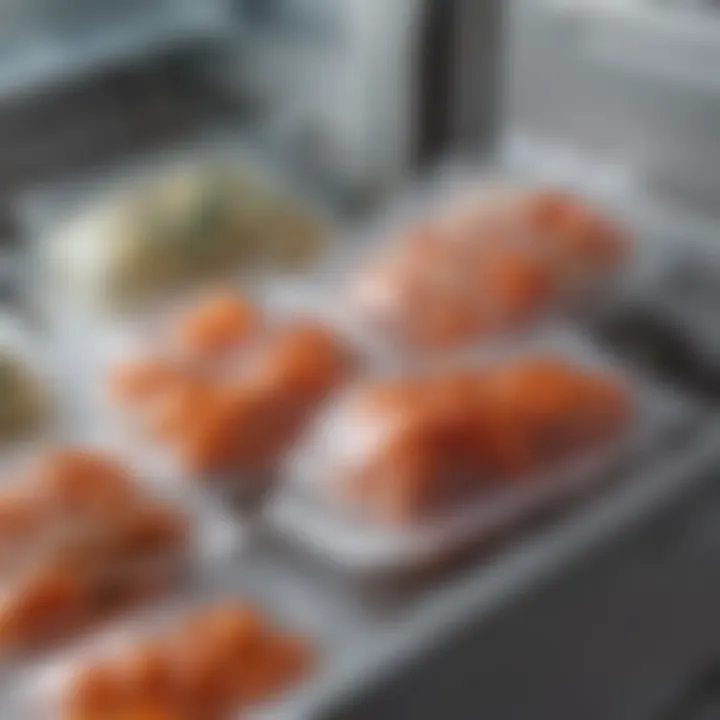
Types of Freezers: Which One is Right for You?
In the grand scheme of food preservation, the type of freezer you choose can play a significant role in determining how well you can maximize your storage capabilities. With options ranging from upright to chest models, understanding the nuances between them is crucial. This section aims to dissect these choices while also considering how energy efficiency impacts your kitchen dynamics.
Upright Freezers vs. Chest Freezers
When it comes to selecting a freezer, the upright and chest varieties stand out. Each type carries its own set of pros and cons, depending notably on the volume, accessibility, and layout of your kitchen.
Upright Freezers mimic standard refrigerators in design, making them a space-saving solution with a variety of shelves allowing easy organization. You're able to see all your items at a glance, simplifying the process of finding what you need. This design is ideal for households that frequently access freezer items, as you don’t have to bend down or sift through stacks of frozen goods. However, they typically have a smaller capacity compared to chest freezers, which can be limiting if you’re looking to stockpile goods or maintain large quantities of frozen items.
On the contrary, Chest Freezers, resembling large boxes, tend to offer more storage space for bulkier items. They save energy due to their insulated design and typically hold temperature better. However, accessing items at the bottom can prove to be a hassle. It often leads to disorganization, as you may find yourself digging through layers of food, potentially losing track of older items that could lead to waste. To maximize the effectiveness of a chest freezer, consider using bins or dividers for better organization.
Ultimately, your choice boils down to your personal needs. If you need quicker access and have limited space, an upright freezer may serve you better. However, for bulk storage and energy efficiency, a chest model might be the golden ticket.
Energy Efficiency Considerations
When considering the myriad of options in freezers, energy efficiency emerges as an essential factor. Freezers run constantly, thus knowing which model plays best in terms of resource consumption can lead to big savings on your utility bills.
High-efficiency models, often marked with the ENERGY STAR label, can save you about 10-25% more energy than traditional models. Not only is this a financial boon, but it also benefits the environment. Moreover, certain features can influence energy usage significantly, such as:
- Defrosting Method: Manual defrosting freezers usually use less energy than automatic ones, although they require regular maintenance.
- Size: A larger freezer consumes more energy. Choose one that fits your needs to keep your costs in check.
- Location: Placing your freezer in a cooler part of the home can lead to better efficiency, as it won’t have to work as hard to keep cool.
Being conscious of your freezer's energy consumption not only saves money but can also contribute positively to a more sustainable kitchen. The right model and careful considerations about placement can make a world of difference.
Organizing Your Freezer for Maximum Efficiency
Organizing your freezer is a game changer. When you walk into a neatly arranged freezer, it's like stepping into a well-oiled machine. Everything is where it oughta be, and you can see what you've got at a glance. Maximizing this space is not simply about aesthetics; it’s about efficiency, which translates into time saved and reduced food waste. With careful organization, you can ensure that every item is easily accessible, minimizing the chances of things getting lost in the icy depths.
Categorizing Food Items
When it comes to categorizing food items, think like a librarian sorting through books, except instead of novels, you’re dealing with a treasure trove of culinary delights. Start by grouping similar items together. For instance, keep all meats in one section, veggies in another, and ready-to-eat meals in a third. You might even consider diving deeper and separating raw proteins from cooked meals to aid in quicker retrieval.
Benefits of this approach include:
- Ease of Access: When you need that package of frozen chicken or a bag of green beans, it won't take ages to find them.
- Inventory Management: You can keep track of what you have and what you’re running low on, which is invaluable for shopping lists.
- Reduced Waste: When you know what you have, you can use older items first, helping to keep everything fresh.
Labeling and Dating Strategies
Labeling and dating your foodstuffs is the unsung hero of freezer organization. It's not glamorous, but it's vital. If you’ve ever pulled out a mystery container and wondered what on earth was in there, you’re well aware of the importance of this practice. A good labeling system can save you from culinary disasters.
Here are some tips to get started:
- Use Clear, Waterproof Labels: A label maker can be a handy tool, but masking tape and a sharpie can work just fine too. Just ensure it’s waterproof to survive the freezer’s conditions.
- Include Key Information: Write down the name of the item, the date it was frozen, and any cooking instructions if applicable.
- Establish a Rotation System: Implement a first-in, first-out method so that older items are always used first. This greatly minimizes the risk of freezer burn.
"A well-labeled freezer is a happy freezer."
Utilizing Storage Bins and Containers
Lastly, integrating storage bins and containers into your freezer organization brings structure to the chaos. Think of them as the drawer dividers but for your freezer. These bins can hold smaller items together, making everything from ice cream to frozen sauces easy to locate.
Consider these approaches:
- Choose Clear Bins: They allow you to see contents without digging around.
- Adjustable Shelves: If you've got an upright freezer, adjustable shelving can be a lifesaver and can help accommodate everything from tall pizza boxes to stacked containers.
- Consider Size and Shape: Use various sizes of bins to maximize space. Small items like single portions of soup can go in one bin while larger items like whole pies can go in another.
Organizing your freezer doesn't have to be an uphill battle. By staying on top of categorization, labeling, and using the right storage solutions, you turn a sprawling, cold wasteland into an efficient food sanctuary. The extra effort pays off, leaving you with a freezer that's not just functional but a really handy tool in your kitchen arsenal.
Freezing Methods: Best Practices
Understanding how to freeze food effectively can truly elevate your experience in food storage and meal prep. It’s not just about tossing leftovers into your freezer and calling it a day; the technique matters a lot. Proper freezing methods not only preserve the nutritional value of the food but also maintain texture, flavor, and overall quality. As we explore freezing practices, we'll delve into critical elements that will ensure you make the most of your freezer, ultimately reducing food waste and saving you money in the long run.
Blanching Vegetables
Blanching vegetables before freezing is an essential step that often gets overlooked. This process involves briefly boiling the vegetables, then quickly plunging them into ice water to halt cooking. Sounds simple, right? However, it’s the scientific reasoning behind it that does wonders for your food.
When you blanch vegetables, you're essentially deactivating enzymes that can cause flavor loss and color changes over time. Additionally, the rapid freeze that follows helps preserve texture, making sure your once crisp green beans remain appetizing weeks later.
Here’s a straightforward process to blanch vegetables:
- Prepare the Set-Up: Fill one pot with boiling water and another with ice water.
- Immerse the Veggies: Place vegetables in the boiling water for a determined time, usually 2-5 minutes depending on the type.
- Shock Them: Once time is up, quickly transfer them to ice water to stop the cooking.
- Drain and Dry: Pat dry before placing them in freezer bags.
Allowing your veggies to cool in this manner is key. They’ll come out looking lively and will taste just as fresh after defrosting.
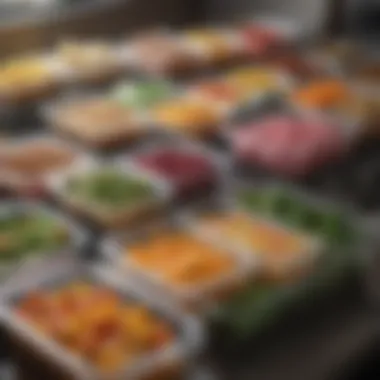
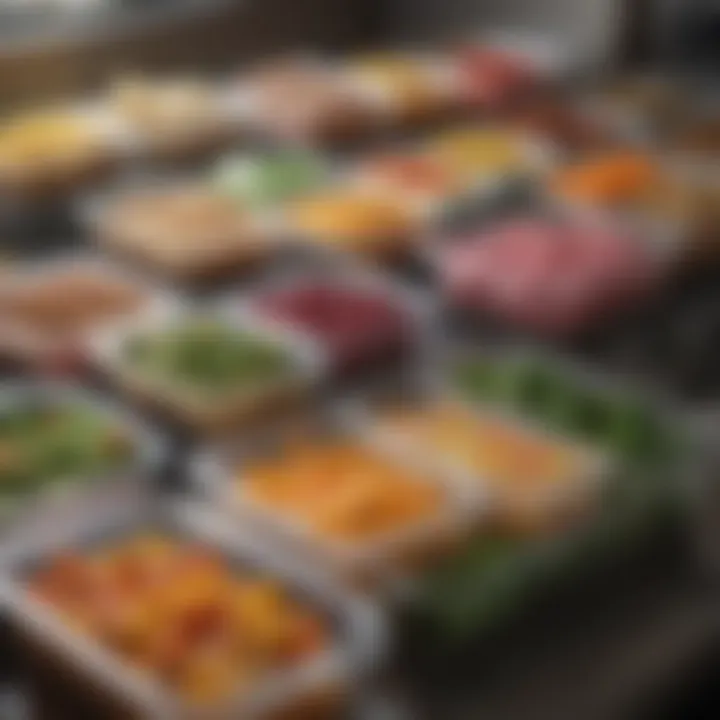
Freezing Cooked vs. Raw Foods
The debate of whether to freeze cooked or raw options is a hot topic among home cooks. Each approach has its benefits, so let’s break it down a bit.
- Freezing Raw Foods: Raw foods are often flash-frozen to maintain their freshness. This method is great for meats and seafood, as it locks in moisture. It is wise to freeze them right after purchasing, as this keeps them how nature intended.
- Freezing Cooked Foods: On the other hand, cooked meals might save you time later. Imagine coming home after a long day and simply reheating a pre-cooked casserole. Freezing cooked foods can also add flavors during cooking that might be hard to replicate in a raw state, like simmering a beef stew that melds flavors beautifully.
Ultimately, whether you opt for cooked or raw often depends on your lifestyle. If you prefer convenience, prepared meals might suit you better. But if you enjoy the cooking process itself, raw food may be the right choice.
Avoiding Freezer Burn
Nobody wants freezer-burned food – it’s like serving a stale cookie at a party; just plain sad. Freezer burn occurs when air comes into contact with food, causing dehydration and oxidation. It’s particularly prevalent in unwrapped or loosely wrapped items.
To prevent this unwanted phenomenon, consider the following strategies:
- Wrap it Tight: Use heavy-duty freezer bags or airtight containers. Remove excess air as you seal to enhance protection.
- Label and Date: Keeping track of the age of items can help avoid older foods becoming culprits of freezer burn. A simple marker works wonders.
- Optimal Temperature: Ensure your freezer is at or below 0°F (-18°C). Colder temperatures mean slower degradation processes, keeping your food safe.
"A well-organized freezer allows you to not just save time and money but to enjoy fresh ingredients year-round."
By paying close attention to these best practices in freezing methods, you’ll not only optimize your food storage but also keep the flavors and textures intact. The mindset of treating your freezer like another kitchen tool can unlock endless culinary possibilities.
Food Safety and Freezer Storage Guidelines
Understanding the importance of food safety and proper freezer storage guidelines cannot be overstated. Both concepts play a pivotal role in maintaining the quality of your food and preventing foodborne illnesses. When food enters your freezer, it doesn't merely find a cold spot to rest; instead, specific rules come into play to ensure that it remains both safe and delicious for future meals. Whether you are a culinary enthusiast or a busy parent managing meal prep, understanding these guidelines helps maintain the integrity of your meals and reduces food waste.
Understanding Temperature Settings
The first line of defense in food safety within your freezer is the temperature setting. It's essential to keep your freezer at or below 0°F (-18°C). At this temperature, most bacteria, yeasts, and molds slow down or stop their activity, preserving food quality and flavor. However, many home freezers are often set at temperatures that are slightly higher, which can compromise the food’s safety and quality.
- To ensure optimal storage:
- Use a thermometer to confirm your freezer's temperature. This device will help you monitor and adjust settings if necessary.
- Avoid frequent opening of the freezer door, as this causes temperature fluctuations that can help spoil food.
- If you notice your freezer temperature rising above the recommended threshold, consume perishable items sooner rather than later, as they may not hold up well.
Furthermore, it’s wise to remember that freezing does not eliminate bacteria but merely puts them into a state of dormancy. When thawed improperly, these bacteria can regain activity and potentially cause food poisoning.
Thawing Processes: Safe Practices
Proper thawing methods are crucial in preventing foodborne illnesses, yet many people are unsure about how to thaw their food safely. The common approach of leaving food out on the kitchen counter overnight is risky. Bacteria thrive on perishable food that remains within the temperature danger zone of 40°F to 140°F (4°C to 60°C). Here are safe ways to thaw your food:
- In the refrigerator: Plan ahead and let your food thaw slowly in the fridge. It keeps the temperature consistent and minimizes bacterial growth.
- Cold water method: Submerge airtight packages of food in cold water, changing the water every 30 minutes. Be cautious that the food isn't above 40°F during this process.
- Microwave thawing: This option is quick but requires caution, as uneven heating can cause parts of the food to enter the danger zone.
Once thawed, ensure to cook the food immediately if the microwave method was used or if the food was submerged in cold water. By following these practices, you'll safeguard your health while enjoying the delights of your frozen treasures.
"Food safety might seem unexciting, but it lays the groundwork for every culinary adventure you embark on. Neglecting these guidelines can lead to waste or worse, an upset stomach."
Creative Meal Preparation with Freezer Ingredients
In today's fast-paced world, utilizing your freezer effectively can significantly ease the cooking burden while opening the door to creative meal solutions. Creative meal preparation using freezer ingredients allows you to embrace spontaneity and variety in your diet without breaking the bank or wasteing food. This section delves into how proper freezer management translates into delicious meals and consistent nourishment that fit neatly into a busy lifestyle.
Batch Cooking Techniques
Batch cooking is arguably one of the most efficient methods for maximizing freezer use. This technique involves preparing large quantities of food at once, which can then be portioned out and frozen for future meals. It not only saves time but also reduces the stress of daily cooking. For instance, spending a weekend afternoon preparing a multitude of meals can provide you with ready-to-eat options for weeks.
To employ batch cooking effectively:
- Choose recipes that freeze well, such as casseroles or baked goods.
- Set aside a specific time each week to prepare meals, encouraging routine.
- Make it a social event; invite friends or family members to join in.
- Use a variety of freezer-safe containers to store portions properly.
The convenience of simply pulling a meal from the freezer can free up time to enjoy hobbies or spend with loved ones, enhancing overall life quality.
Freezer-Friendly Recipes
Crafting meals that are specifically designed to thrive in your freezer is a game changer. There are three standout categories that cater to this notion: soups and stews, marinated proteins, and homemade sauces. Each category brings unique attributes that align with an efficient, tasty meal prep strategy.
Soups and Stews
Soups and stews are among the finest choices when it comes to freezer-friendly recipes. Their ability to meld flavors over time makes them not only nutritious but also convenient. A hearty soup can be a comfort in a bowl—filled with vegetables, beans, or lentils, it's both filling and health-conscious.
The key characteristic of soups and stews lies in their flexibility. You can toss in whatever vegetables, grains, or proteins you have on hand, making it a perfect choice for cleaning out the fridge.
One unique feature is their long shelf life in the freezer; many soups can last for up to six months without compromising flavor. Yet, one must be cautious, as certain thickeners like cream may not freeze and thaw well.
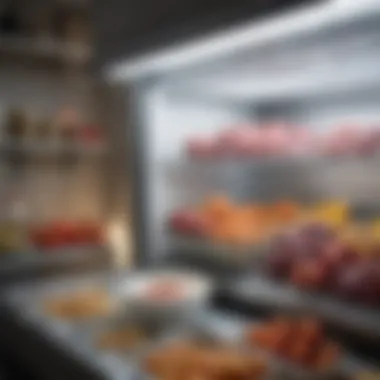
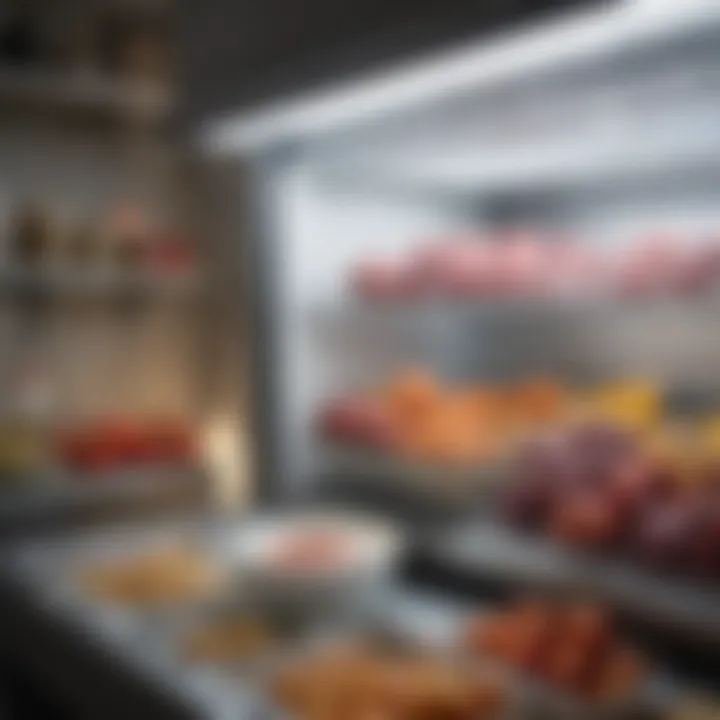
Marinated Proteins
The beauty of marinated proteins is how they can transform a simple dish into a flavor-packed experience. Proteins like chicken, fish, or tofu can absorb spices or marinades, creating depth and richness.
A standout aspect of marinated proteins is their ease of preparation. By marinating in bulk and then freezing, you set yourself up for swift meals with far less work during the week. This technique is particularly beneficial for those busy weeknights when time is tight but nutrition desirably remains.
An important note here is the potential for texture changes upon freezing. Certain delicate proteins may become a bit rubbery if stored too long, so it's best to use them within three months.
Homemade Sauces
Homemade sauces can be the secret weapon in your culinary arsenal, transforming any bland meal into something spectacular. These can include sauces like marinara, pesto, or even a zesty taco sauce.
The key characteristic here is versatility. A good sauce can elevate a variety of base foods, from pasta to grilled meats or veggies. By preparing in bulk and freezing, you ensure that flavorful complexities are available at your fingertips.
Its unique feature is the intense flavor development that occurs when sauces are allowed to meld together, which only gets better as they sit in the freezer. However, consider that not all sauces freeze equally well; cream-based sauces can separate and lose their appeal after thawing, so plan accordingly.
"Cooking is like love. It should be entered into with abandon or not at all." - Harriet van Horne
Proper Maintenance of Your Freezer
Maintaining your freezer is not merely about keeping food frozen; it's about preserving investment and ensuring efficiency. A well-maintained freezer not only enhances the longevity of stored foods but also encourages energy-saving practices. When you think about it, the freezer is often the unsung hero of the kitchen, quietly working behind the scenes to minimize waste and spruce up meal prep. Let's delve into some aspects of maintaining this crucial appliance.
Routine Cleanliness Practices
Keeping your freezer clean is akin to giving it a spa day. It’s essential, not just for hygiene but for functionality. Here are some practices to ensure your freezer stays in tip-top shape:
- Regular Defrosting: If you have a manual freezer, ice buildup can become a major issue. Make it a habit to defrost your freezer at least once or twice a year to avoid blockages and improve energy efficiency.
- Wipe Down Surfaces: A simple mix of water and baking soda can work wonders. Wiping down interior surfaces on a routine basis can help remove spills and prevent odors from setting in.
- Check for Spills: Regularly inspecting for spills is key. Leftover food particles can attract unwanted odors or even frost build-up.
- Keep it Organized: An organized freezer means less mess. When items are stored neatly, it's easier to identify what needs using, cutting down on forgotten food waste.
Staying on top of these measures means you won't face unexpected surprises, like finding forgotten ground beef from last year's BBQ.
Identifying Signs of Freezer Failure
An aware freezer owner knows what to watch for. Detection of early signs of freezer problems can save you from disaster down the line. Here’s what to keep an eye out for:
- Temperature Fluctuations: If your freezer’s temperature starts dancing around, it could signal that something's off. Ideally, it should stay at or below 0°F (-18°C). Consider getting a thermometer for a second opinion.
- Frost Accumulation: Excessive frost is not just an aesthetic problem. It’s a sign that your freezer is working over its limits. A buildup can inhibit airflow and cause uneven temperature.
- Unusual Noises: Listen closely; strange sounds can indicate mechanical issues. If you hear clunking or grinding noises, it might be time to consult a professional.
- Condensation: Sweat on the exterior or pooling moisture can point to door seal problems. Inspect the rubber gaskets around the doors for cracks or tears. A faulty seal lets in warm air, which can wreak havoc on your food.
"A stitch in time saves nine." Keeping particularly watchful eyes on these signals can prevent major hiccups and save you from losing your hoard of carefully stored meals.
Addressing Common Freezer-related Issues
At times, even the most diligent freezer user can encounter issues that throw a wrench into their food preservation plans. Addressing common freezer-related issues is crucial for maintaining efficiency and ensuring that your stored food remains safe and delicious. From power outages to dealing with limited space, understanding how to tackle these challenges can save money, reduce waste, and keep your meals on track.
Power Outages: What to Do
Power outages are not only inconveniences but can also threaten the safety and quality of food stored in your freezer. When the power goes out, the first instinct may be to panic, but there are practical steps to take that can help.
- Keep the Door Closed: One of the golden rules during a power outage is to keep the freezer door shut. This maintains the cold temperature within, potentially preserving food for up to 48 hours in a fully loaded freezer. If it’s only half-full, that period shrinks to about 24 hours.
- Monitor the Temperature: If possible, use a thermometer to monitor the temperature inside your freezer. Ideally, it should stay at or below 0°F (-18°C) for food safety. If the temperature rises above that, perishable items like meats and dairy may begin to spoil.
- Plan for the Worst: In case of prolonged outages, familiarize yourself with freezer-friendly foods and how long they remain safe. For example, frozen vegetables or pre-cooked meals might last longer, but raw meats can be a concern after a day without power.
- Consider Ice Packs: It's a smart move to keep ice packs or bags of ice handy. They can be placed in the freezer before an anticipated outage, helping maintain lower temperatures longer.
"Preparedness today can save your dinner tomorrow."
Managing Overcrowded Freezers
An overflowing freezer not only leads to frustration but can also hamper food preservation and efficiency. Managing overcrowded freezers requires a keen eye for organization and a willingness to adjust your storage habits.
- Take Inventory: Start by taking a proper inventory of what’s inside. This includes making a list, so you know what items you have on hand, preventing duplicate purchases and waste. Knowing is half the battle.
- Prioritize Basics: Store frequently used items at the top or front of the freezer for easy access. This way, you aren’t sifting through five pounds of frozen broccoli to reach your ground beef.
- Use Clear Containers: Opt for clear, stackable containers or bins that allow you to see contents at a glance. Label them clearly, indicating the contents and the date frozen. This simplifies searching and ensures you use older items first.
- Regularly Rotate Stock: Make it a habit to rotate stock regularly, adhering to the “first in, first out” principle. When you freeze new items, place them at the back while pulling older items to the front.
- Consider Thawing and Using Up: If your freezer is overflowing, it might be time for a big cooking day. Thawing items can lead to various meal prep sessions, turning potential waste into delightful dinners.
By taking proactive measures, you can avoid the hassle that comes with a cramped freezer. These strategies empower you to utilize every inch effectively, reducing food waste and enhancing your overall food preparation experience.
Innovative Uses for Your Freezer
Maximizing the functionality of your freezer goes beyond merely storing food items for later use. There are countless innovative strategies to take advantage of this appliance, transforming it into a crucial ally in modern culinary practices. Taking the time to explore fresh approaches can not only simplify your meal prep but also expand your cooking repertoire. So let's dig into some of these creative uses.
Freezing Fresh Herbs
Herbs are the unsung heroes of flavor in any kitchen. Yet, they often wilt and expire before you can use them. Here’s where your freezer comes in. By freezing fresh herbs, you preserve their vibrant flavors and textures for future use.
To freeze herbs properly, start by cleaning them thoroughly. Once dried, you can choose to chop them or leave them whole according to your preference. An effective method is to fill an ice cube tray with chopped herbs and cover them with olive oil or water. After freezing, transfer the cubes to a labeled freezer bag. This way, you have instant flavor boosters ready to toss into any dish, be it soups, sauces, or even a simple salad.
"Freezing herbs is a game changer! It saves time and ensures you always have a sprinkle of fresh flavor on hand."
Creating Freezer Pops for Refreshing Treats
During those sweltering summer days, nothing beats a cool, refreshing treat. Why not make freezer pops? This simple and fun method allows you to tailor pops to your taste, avoiding the overly sweetened commercial options.
Start by choosing your favorite fruit, whether it be strawberries, blueberries, or something exotic like mangoes. Blend the fruit with yogurt or juices, adding a touch of honey or agave syrup for sweetness if desired. Pour this mixture into molds, inserting sticks before freezing. In just a few hours, you’ll have delightful, refreshing freezer pops that can be enjoyed by adults and kids alike.
Moreover, these homemade pops are not only tasty but also a healthier alternative to store-bought goodies. By controlling the ingredients, you can cater to dietary needs and preferences, even sneaking in some spinach if you’re feeling adventurous!







